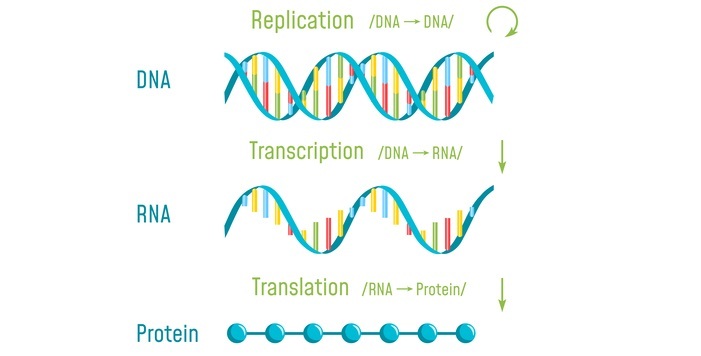
 Data Structure
Data Structure Networking
Networking RDBMS
RDBMS Operating System
Operating System Java
Java MS Excel
MS Excel iOS
iOS HTML
HTML CSS
CSS Android
Android Python
Python C Programming
C Programming C++
C++ C#
C# MongoDB
MongoDB MySQL
MySQL Javascript
Javascript PHP
PHP
- Selected Reading
- UPSC IAS Exams Notes
- Developer's Best Practices
- Questions and Answers
- Effective Resume Writing
- HR Interview Questions
- Computer Glossary
- Who is Who
Translation Mechanism and Clinical Significance
Introduction
The translation is a process by which the genetic information contained in the mRNA (messenger RNA) is decoded to produce a protein. The process of translation is a complex mechanism that occurs in every living cell and is essential for the proper functioning of the organism.
It is a crucial step in the central dogma of molecular biology, which states that the information contained in DNA is transcribed into mRNA, and then translated into a protein.

What is Translation Mechanism
The translation mechanism is the process of decoding the mRNA sequence into a specific sequence of amino acids, which ultimately leads to the production of a protein. This mechanism involves several stages, including initiation, elongation, and termination.
Initiation is the process by which the ribosome recognizes the start codon (AUG) on the mRNA and binds to it.
Elongation is the process by which the ribosome reads the codons on the mRNA and adds the corresponding amino acid to the growing protein chain. Termination is the process by which the ribosome recognizes the stop codon (UAA, UAG, or UGA) on the mRNA and releases the completed protein.

How Does It Work
The process of translation is as follows ?
Translation begins when the ribosome recognizes the start codon (AUG) on the mRNA.
The ribosome then binds to the mRNA and initiates the process of elongation.
During elongation, the ribosome reads the codons on the mRNA and adds the corresponding amino acid to the growing protein chain.
The ribosome moves along the mRNA, reading each codon and adding the corresponding amino acid until it reaches the stop codon (UAA, UAG, or UGA).
The ribosome then releases the completed protein.
For example, let us consider the mRNA sequence AUGUUUCAG.
The start codon AUG signals the ribosome to begin translation.
The ribosome reads the first codon (UUU) and adds the corresponding amino acid (phenylalanine) to the growing protein chain.
The ribosome then reads the second codon (CAG) and adds the corresponding amino acid (glutamine) to the growing protein chain.
The process continues until the ribosome reaches the stop codon (UAG), and the completed protein is released.
What Are the Different Types of Translation Mechanisms?
There are two types of translation mechanisms: Prokaryotic translation and Eukaryotic translation.
Prokaryotic translation occurs in prokaryotic cells, such as bacteria.
Eukaryotic translation occurs in eukaryotic cells, such as plant and animal cells.
Prokaryotic translation differs from eukaryotic translation in several ways.
In prokaryotic cells, transcription and translation occur simultaneously, whereas, in eukaryotic cells, transcription and translation are separated by the nuclear membrane.
Prokaryotic mRNA lacks introns, whereas eukaryotic mRNA contains introns that must be spliced out before translation can occur.
Prokaryotic ribosomes are smaller and simpler than eukaryotic ribosomes.
What Is the Clinical Significance?
Translation has significant clinical significance, and its dysregulation has been implicated in several diseases. Here are some examples ?
Genetic Disorders
Many genetic disorders are caused by mutations that affect translation. For example, mutations in the CFTR gene, which encodes a protein involved in chloride ion transport, can cause cystic fibrosis.

Cancer
Dysregulation of translation has been implicated in cancer. Some cancer cells exhibit increased rates of translation, which enables them to synthesize proteins at a faster rate than normal cells.
Antibiotics
Many antibiotics target the bacterial translation mechanism. For example, tetracyclines bind to the bacterial ribosome and prevent elongation, effectively halting translation and killing the bacteria.
Therapeutics
Translation is a potential target for therapeutic intervention. For example, antisense oligonucleotides (ASOs) can be used to target specific mRNA sequences and inhibit translation. This approach has been used to treat diseases such as spinal muscular atrophy, a genetic disorder caused by mutations in the SMN1 gene.
In conclusion, the translation mechanism is a fundamental process that occurs in every living cell and is essential for the proper functioning of the organism. Dysregulation of translation can lead to a wide range of diseases, highlighting the clinical significance of this process. Understanding the translation mechanism is therefore crucial for developing effective therapies for these diseases.
FAQs
Q1. How does translation differ from transcription?
Ans. Transcription is the process of copying the genetic information contained in DNA into mRNA. Translation is the process of decoding the mRNA sequence into a protein.
Q2. What is the role of the ribosome in translation?
Ans. The ribosome is the molecular machine that carries out the process of translation. It reads the codons on the mRNA and adds the corresponding amino acid to the growing protein chain.
Q3. What is the genetic code?
Ans. The genetic code is the set of rules by which the sequence of nucleotides in DNA and RNA is translated into the sequence of amino acids in a protein.
Q4. What are some diseases caused by dysregulation of translation?
Ans. Examples include cystic fibrosis, cancer, and spinal muscular atrophy.

